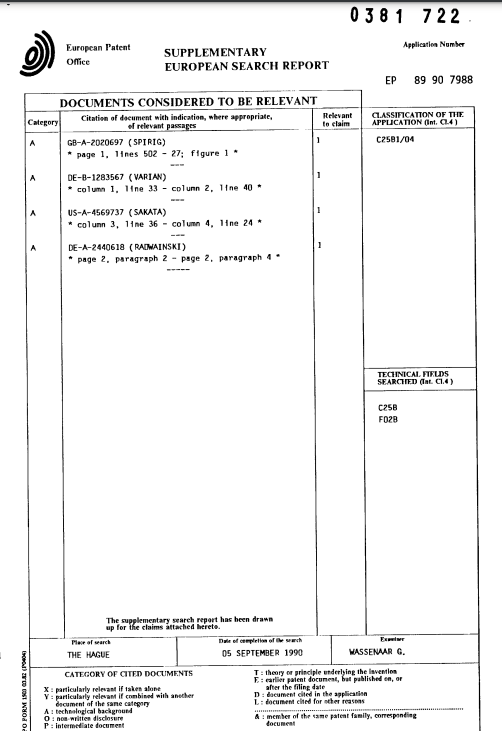EP0381722A4 Hydrogen Aeration Injection System
WHAT IS CLAIMED IS:
-
A method of obtaining the release of a gas mixture including hydrogen and other dissolved gases entrapped in water, from water, consisting of:
- (A) providing a capacitor, in which the water is included as a dielectric between capacitor plates, in a resonant charging choke circuit that includes an inductance in series with the capacitor;
- (B) subjecting the capacitor to a pulsating, unipolar electric field in which the polarity does not pass beyond an arbitrary ground, whereby the water molecules within the capacitor are subjected to a charge of the same polarity;
- (C) further subjecting the water in said capacitor to said pulsating electric field to achieve a pulse frequency such that the pulsating electric field induces a resonance within the water molecule;
- (D) continuing the application of the pulsing frequency to the capacitor after resonance occurs so that the energy level within the molecule is increased in cascading incremental steps in proportion to the number of pulses;
- (E) maintaining the charge of said capacitor during the application of the pulsing field, whereby the co-valent electrical bonds of the hydrogen and oxygen atoms within said molecules is destabilized, such that the force of the electrical field applied within the molecule exceeds the bonding force of the molecule, and hydrogen and oxygen atoms are liberated from the molecule as elemental gases; and
- (F) collecting said hydrogen and oxygen gases, and any other gases that were formerly dissolved within the water and discharging said collected gases as a fuel gas mixture.
-
The method of claim 1 including the further steps of:
- (A) subjecting the collected gas mixture to a pulsating, polar electric field whereby electrons of the gas atoms are distended in their orbital fields by reason of their subjection to electrical polar forces, at a resonance with respect to an electron of the gas atom;
- (B) affecting said gas atoms with respect to their positive electrical field such that the energy level of the resident electron is increased in cascading incremental steps;
- (C) ionizing said gas atoms;
- (D) subjecting the ionized gas atoms to electromagnetic wave energy having a predetermined frequency to induce a further electron resonance in the ion, whereby the energy level of the electron is successively increased;
- (E) extracting further electrons from the resonating ions while said ions are in an increased energy state, releasing the nuclear and electron configuration of the atoms; and
- (F) subjecting the destabilized ions to thermal ignition, whereby thermal energy having a level enhanced over conventional combustion is achieved.
-
In an apparatus for obtaining the release of a gas mixture including hydrogen and other dissolved gases entrapped in water, from water, the improvement consisting of a resonant electronic circuit in operative relationship with the water in which the dielectric property of water determines the resonance of the circuit.
-
The apparatus of Claim 3, in which the resonant circuit includes a resonant charging choke.
-
The apparatus of Claim 3 or Claim 4 in which water is included as a dielectric between conductive plates that form a capacitor in the resonant circuit.
-
An apparatus in accordance with Claim 3 or Claim 4 or Claim 5 further including successively interconnected:
- (A) means for providing a pulsating, polar electric field to the gas mixture, whereby electrons of the gas atoms are distended in their orbital fields by reason of their subjection to electrical polar forces, at a frequency such that the pulsating electric field induces a resonance with respect to an electron of the gas atom; and the energy level of the resident electron is increased in cascading, incremental steps; and
- (B) means for providing a further electric field to ionize said gas atoms;
said further means connected to an electromagnetic wave energy source for subjecting the ionized gas atoms to wave energy of a predetermined frequency to induce a further electron resonance in the ion, whereby the energy level of the electron is further successively increased; and
- (C) an electron sink for extracting electrons from the resonating ions while such ions are in an increased energy state to destabilize the nuclear and electron configuration of said ions;
- (D) a control means for directing particle flow in a continuous manner through the electric fields, wave energy source and electron sink into a final stage at which the destabilized ions are thermally ignited; and
- (E) a thermal device at which the mixture of gases provided by the first means, after having passed through and been processed by the preceding means of the apparatus, is thermally ignited.
-
The method and apparatus as substantially described herein.

